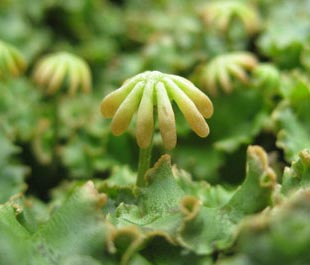Mosses & Liverworts
What are mosses?

There are two groups of bryophyta (see Plant Kingdom). One of them is mosses which represent an evolutionary step up from algae. They are simple green land plants with leaves and a stem and always without roots.
In many mosses, the leaves are only one cell thick, except for the midribs, which are sometimes present. The plant is normally attached to the ground by delicate, colourless or brown threads, the rhizoids.
Most mosses are found in areas with a humid and a cold to moderate warm climate. In the tropics, mosses are found especially in the mountains. In Europe, the south-western part of Ireland is a paradise for mosses.
Mosses can reproduce asexually, by means of small clusters of cells or plates of tissue which break away and germinate to become new plants. Especially liverworts do this. It is believed by scientists that as the first land plants, mosses probably created the first forests, mini-ecosystems just 5cm or so high.
What are liverworts?

The other group of bryophyta are Liverworts. They are very similar to mosses. However, where the pointed `leaves' of mosses are arranged in spirals on the stems, liverworts have rounded (liver-shaped) `leaves' which grow flat in double rows.
There are approximately 8,500 species of liverworts. They are widely distributed, occurring from the arctic to the tropics. Although some grow in relatively dry places and a few are submerged aquatics, most liverworts occur in places where moisture is generally available, e.g., on damp soil or moist rotting logs, along shaded stream banks, on rocks in streams, or on wet rock outcroppings; a few even grow under saline conditions.